Music Theory - Lesson #4
LESSON #4 – Major Scales That Have Sharps
Last week I wrote about chromatic and diatonic semitones as well as notes, rests and time values. In case you missed it here is the link: https://steemit.com/music/@hurtinalbertin/music-theory-lesson-3
This week I will introduce you to major scales.
These are simple concepts that you may already understand, but if you find that it is a lot to take in all at once, look it over carefully and don’t move on until you completely understand each concept fully. The objective here is to build a solid foundation of knowledge and build on it. If you forgot something that was covered go back and look it over again.
MAJOR SCALES:
A scale is a series of notes whose names are in alphabetical order. In the case of the major scale there are eight notes in the scale. The notes in the scale are numbered from the bottom up and roman numerals are used instead of regular numbers. You may also refer to these numbers as degrees. All major scales have a specific pattern of whole tones and semitones which occur in this order:

Major scales can start on any note but must follow this pattern. Scales can also be called keys because once the key or scale of a piece of music is determined, you can derive the chords and melody of that piece of music from the scale. There are three notes that are very important in the major scale. They are more important than any of the others, in order if importance they are:
I - The Key Note, Root or Tonic. This note is the scale name.
V- The Dominate Note.
IV - The Subdominate Note.
SCALE OF C MAJOR:
The scale of C Major is an all natural scale. There are no accidentals in the scale and all other major scales will have one or more sharps or flats to fit the pattern above. To write the scale of C Major start at C and write a note on each line and in each space until you come back to C. Check the scale you have written against the pattern of whole tones and semitones and you will see that no accidentals are needed.
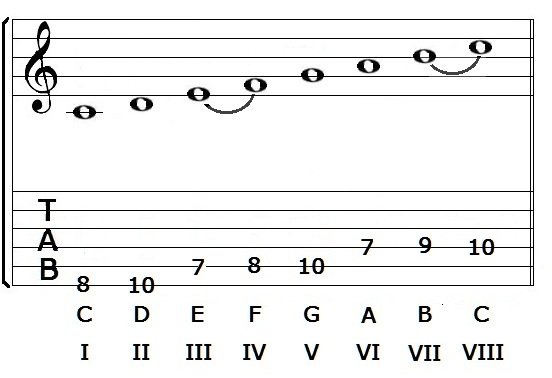
SCALE OF G MAJOR:
To write the scale of G Major start at G and write a note on each line and in each space until you come back to G.
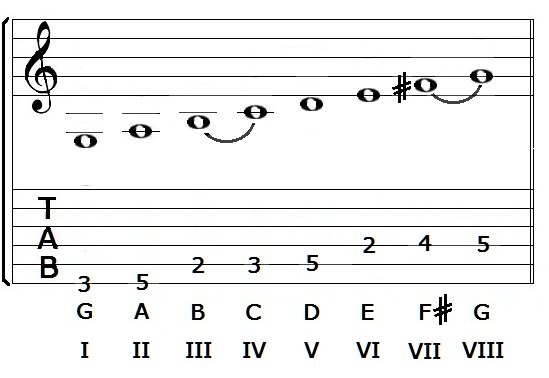
Check the scale you have written against the pattern of whole tones and semitones and you will see that there needs to be a whole tone between the sixth and seventh notes and a semitone between the seventh and eighth notes so the F needs to be raised to F# to fit the pattern correctly.
Instead of writing sharp in front of every F in a piece of music in G Major, the sharp is usually written at the beginning of the staff right after the clef sign showing that ALL F’s in the piece of music no matter where they are on the staff must be sharp. This is called a Key Signature.
This is the Key Signature of G Major. Notice the position of the F# in each clef.
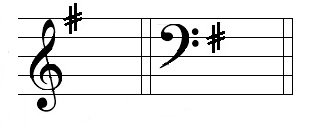
SCALE OF D MAJOR:
To write the scale of D Major start at D and write a note on each line and in each space until you come back to D.
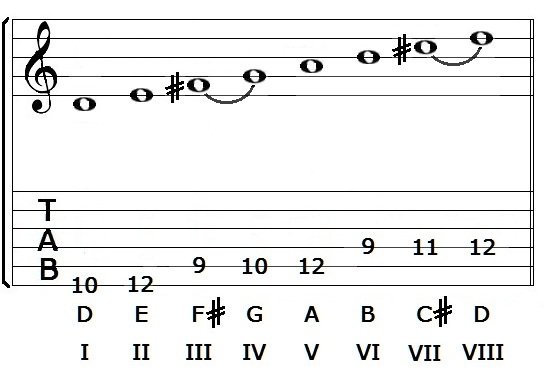
Check the scale you have written against the pattern of whole tones and semitones and
you will see that there needs to be a whole tone between the second and third notes and a
semitone between the third and fourth notes so the F needs to be raised to F#.
There also needs to be a whole tone between the sixth and seventh notes and a semitone
between the seventh and eighth notes so the C needs to be raised to C# to fit the
pattern correctly.
The Key Signature of D Major has two sharps F# and C# as shown below.
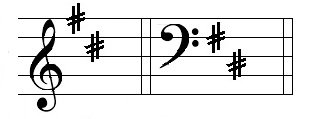
SCALE OF A MAJOR:
To write the scale of A Major start at A and write a note on each line and in each space until you come back to A.
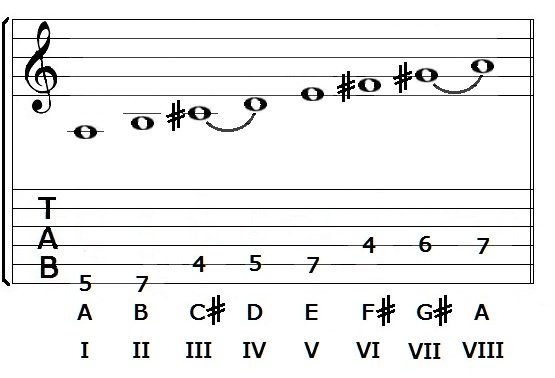
Check the scale you have written against the pattern of whole tones and semitones and
you will see that there needs to be three sharps in order for it to fit into the pattern. The
scale of A Major will have a C#, F# and G#.
The Key Signature of A Major has three sharps C#, F# and G# as shown below.
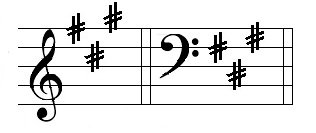
SCALE OF E MAJOR:
To write the scale of E Major start at E and write a note on each line and in each space
until you come back to E.
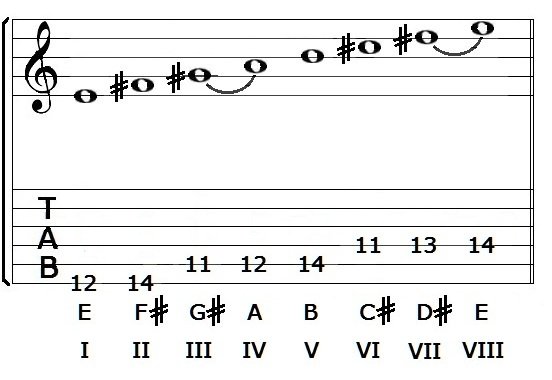
Check the scale you have written against the pattern of whole tones and semitones and
you will see that there needs to be four sharps in order for it to fit into the pattern. The
scale of E Major will have an F#, G#, C# and D#.
The Key Signature of E Major has four sharps F#, G#, C# and D# as shown below.
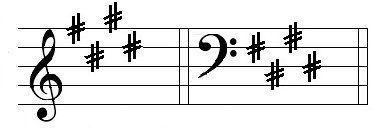
To write the scale of B Major start at B and write a note on each line and in each space
until you come back to B.
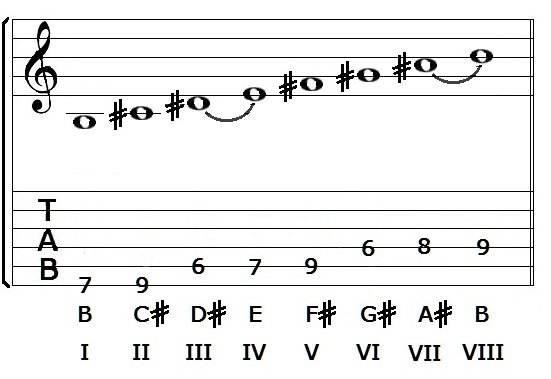
Check the scale you have written against the pattern of whole tones and semitones and
you will see that there needs to be five sharps in order for it to fit into the pattern. The
scale of B Major will have a C#, D#, F# G# and A#.
The Key Signature of B Major has five sharps C#, D#, F#, G# and A# as shown below.
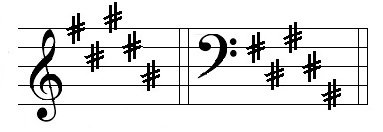
SCALE OF F# MAJOR:
To write the scale of F# Major start at F and write a note on each line and in each space
until you come back to F.
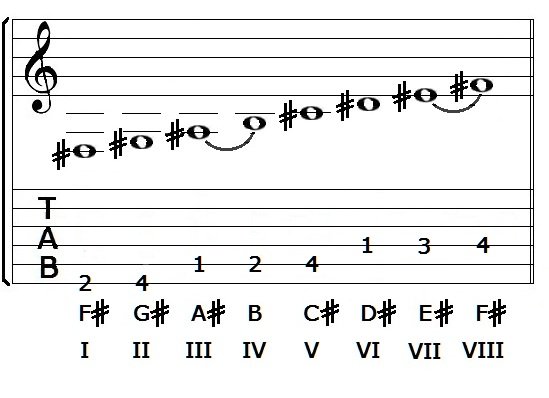
Check the scale you have written against the pattern of whole tones and semitones and
you will see that there needs to be six sharps in order for it to fit into the pattern. The
scale of F# Major will have a F#, G#, A# C#, D# and E#.
The Key Signature of F# Major has six sharps F#, G#, A# C#, D# and E# as shown
below.

SCALE OF C# MAJOR:
To write the scale of C# Major start at C and write a note on each line and in each space
until you come back to C.

Check the scale you have written against the pattern of whole tones and semitones and
you will see that there needs to be seven sharps in order for it to fit into the pattern. The
scale of C# Major will have a C#, D#, E# F#, G#, A# and B#.
The Key Signature of C# Major has seven sharps C#, D#, E# F#, G#, A# and B# as
shown below.

To sum up, here is a listing of keys and the number of sharps that they have.
C Major = 0 Sharps
G Major = 1 Sharp - F#
D Major = 2 Sharps - F#, C#
A Major = 3 Sharps - F#, C#, G#
E Major = 4 Sharps - F#, C#, G#, D#
B Major = 5 Sharps - F#, C#, G#, D#, A#
F# Major = 6 Sharps - F#, C#, G#, D#, A#, E#
C# Major = 7 Sharps - F#, C#, G#, D#, A#, E#, B#
The way that I remember these keys and the order that they come in is by saying this little
Sentence: Charlie, Go Down And Eat Baked Fish, and I remember that the F is F# Major
and there is a C# Major at the end.
The sharps on the keys always follow a cretain order as well it is FCGDAEB. The way I
remember this is with the sentence: Father Charles Goes Down And Ends Battle.
I am hoping that as you read this some patterns are arising as well, for instance if you
count to the fifth or Dominate note in the scale C Major, you will notice that the fifth note
in this scale is G. G Major is the next scale having one sharp.
If you count to the fifth or Dominate note in the scale G Major, you will notice that the
fifth note in this scale is D. D Major is the next scale having two sharps.
If you count to the fifth or Dominate note in the scale D Major, you will notice that the
fifth note in this scale is A. A Major is the next scale having three sharps. This holds
true right up to C# Major.
Another pattern you should notice is the patern on the guitar neck for the major scale.
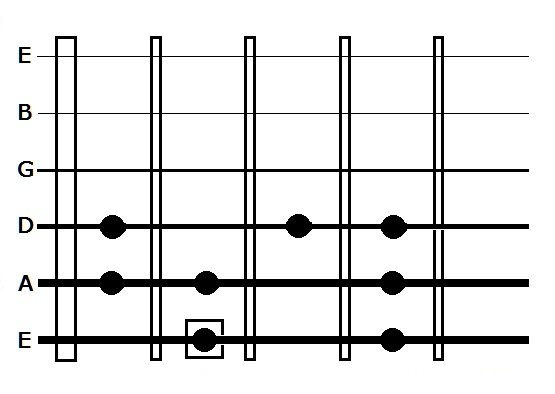
This pattern can be played anywhere on the neck of the guitar and the root or name of
the major scale is the dot with the square around it. So if you were to move this pattern
to where the dot with the square is on the third fret, you would be playing the scale G
Major. If you were to move this pattern to where the dot with the square is on the
seventh fret, you would be playing the scale B Major.
This pattern can also be extended to two octaves as below. It is a good idea to memorize
this pattern.
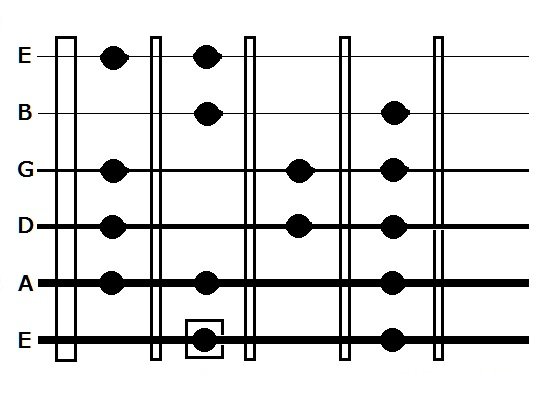
I will stop here and we will continue next week with lesson #5 – Major Scales With Flats. Please comment or write questions below I will respond.
Cool post idea. I played guitar for like 2 years before i learned my scales. Lots of kids just play tabs and never learn them. I try telling my nephew, he'll figure it out eventually.
I played guitar for probably 30 years before I learned scales. I couldn't find a guitar teacher that new the theory and could tell me how it worked. I'm the kind of person who has to know how everything otherwise it's too hard for me to wrap my head around.